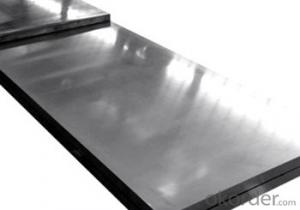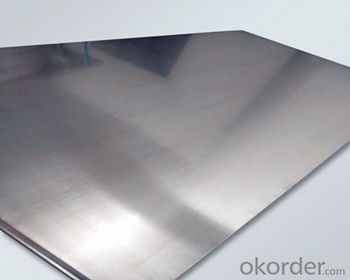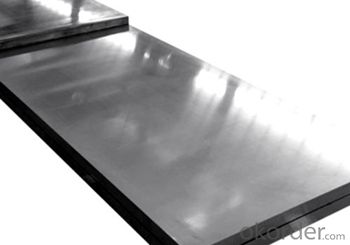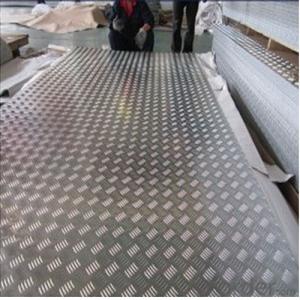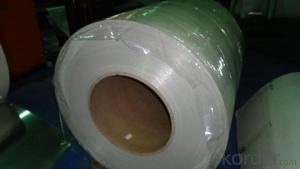High Quality 1060 Aluminum Diamond Plate Sheets with a Good Price
- Loading Port:
- Qingdao
- Payment Terms:
- TT OR LC
- Min Order Qty:
- 10000 kg
- Supply Capability:
- 100000 kg/month
OKorder Service Pledge
OKorder Financial Service
You Might Also Like
Specification
1060 Aluminum Sheet
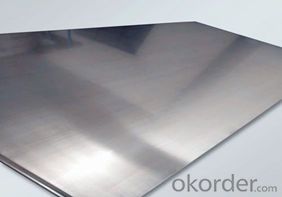
1060 Aluminum Sheet Introduction
1060 aluminum sheet belt, aluminum content of 99.6% or more also known as pure aluminum sheet, belongs to a series of commonly used in the aluminium sheet family. The advantages of this series of aluminum: the most commonly used series, the production process is relatively simple, relatively mature technology, the price relative to other high-grade aluminum alloy has a huge advantage. Has a good elongation and tensile strength, fully able to meet the conventional processing requirements (stamping, stretching) high molding. For industrial pure aluminum, with high plasticity, corrosion resistance, conductivity and thermal conductivity, but the strength is low, heat treatment can not strengthen the machinability is not good; gas welding, hydrogen welding and welding, easy to braze; easy to bear the Pressure processing and extension, bending.
1060Aluminum Sheet Application Scope
1060 aluminum sheet is widely used in products with low strength requirements. Products used in signs, billboards, building exterior decoration, bus body, high-rise and factory wall decoration, kitchen sink, lamp holder, fan blades, electronic parts, chemical equipment, sheet metal processing, deep drawing or spinning Shaped ware, welding parts, heat exchangers, bell surface and disk, nameplate, kitchen utensils, decorations, reflective equipment and so on.
1060 Aluminum Sheet Picture
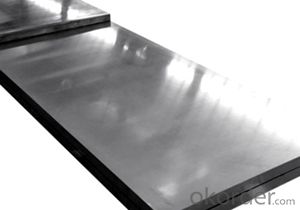
1060 Aluminum Sheet Technical parameters
| Alloy | 1060 Aluminum sheet |
| Temper | O,H14,H16,H18,H22,H24,H26 |
| Thickness (mm) | 0.2 ≤ T≤ 1.0 |
| Width (mm) | 820 ≤ W ≤ 1200 |
| Length (mm) | 1000 ≤ L ≤ 3000 |
| Tensile strength σb (MPa) | 110-136 |
| Elongation rate δ10 (%) | 3-5 |
| Chemical Composition | Al :99.60 Si :0.25 Cu :0.05 Mg:0.03 Zn:0.05 Mn:0.03 Ti :0.03 V:0.05 Fe: 0.350 |
| Typical products | Aluminum-plastic plate, lamp material, fan leaves, capacitor shell, etc |
Introduction of our company
Our company is a professional Aluminium Strip manufacturer and Aluminum Circles manufacturers,mainly supply Aluminium Coil,Aluminum Circles,Aluminium discs,Aluminum Sheet,Aluminum Strip, Household Aluminum Foil,Aluminum Foil for Pharmaceutical Packaging,Aluminum Foil Tape,Aluminum Foil for Air Conditioner,Aluminum Foil for Container etc. series of aluminum products, sincerely welcome everyone to visit.
- Q: Are aluminum sheets suitable for use in automotive or aerospace industries?
- Yes, aluminum sheets are suitable for use in both the automotive and aerospace industries. Aluminum is widely used in these industries due to its lightweight yet strong properties, corrosion resistance, and good thermal and electrical conductivity. It is commonly used in the construction of vehicle bodies, aircraft frames, and various aerospace components.
- Q: What is the hardness rating of 101 aluminum sheets?
- The hardness of 101 aluminum sheets can vary due to various factors, including alloy composition, heat treatment, and manufacturing processes. Generally, aluminum alloys are considered to have relatively low hardness compared to other metals. While the Rockwell hardness scale is commonly used for measuring metal hardness, it is not typically used for aluminum. Instead, the Brinell or Vickers hardness tests are more commonly employed for aluminum alloys. Without detailed information regarding the alloy composition and specific heat treatment applied to the 101 aluminum sheets, it is challenging to provide an exact hardness rating. Therefore, it is advised to consult the manufacturer or supplier of the specific 101 aluminum sheets to obtain accurate hardness information.
- Q: I'm wanting to buy colorguard poles, and I found some good deals on aluminum and fiberglass ones. But what are the pros and cons of each one?
- I'd say fiberglass because... - Durability - Aluminum is a very bendable metal. It dents, it bends, and it breaks easier than any other metal pole you'll find. This is because it's a very low density metal. - Flexibility = more dramatic twirling due to pole flex, and it's less breakable. - Counter Weight = A flag on one side of the pole would be harder to move around swiftly without a counterweight. Thus a heavier pole would entail having a center of gravity on the flag pole closer to the hand, making it easier to maneuver the flag, but the pole would be harder to lift as a whole. I'm no expert on colorguard poles, though. Fiberglass has come a long way. While aluminum is always the same material, fiberglass is a constantly evolving building material.
- Q: Can aluminum sheets be laser engraved?
- Yes, aluminum sheets can be laser engraved.
- Q: Can aluminum sheet be used for insulation?
- Although aluminum sheet can be utilized for insulation purposes, it is not as efficient as alternative insulation materials like fiberglass or foam. This is due to its low thermal conductivity, which implies that it is not a proficient heat conductor. Nevertheless, aluminum lacks adequate insulating properties on its own since it does not offer substantial resistance to heat flow. To enhance its effectiveness for insulation, aluminum sheet is frequently combined with other insulating materials. For instance, aluminum foil is commonly employed as a radiant barrier in buildings to reflect heat and diminish the amount of heat transferred through walls and roofs. In summary, while aluminum sheet can contribute to insulation, it is typically employed in conjunction with other materials to provide superior thermal insulation.
- Q: What are the dimensions of standard aluminum sheets?
- The dimensions of standard aluminum sheets vary depending on the intended application. However, common sizes for standard aluminum sheets range from 0.02 to 0.249 inches in thickness, 36 to 72 inches in width, and 96 to 144 inches in length.
- Q: Can aluminum sheets be used for cladding?
- Yes, aluminum sheets can definitely be used for cladding. Aluminum is a popular choice for cladding due to its many beneficial properties. It is lightweight, durable, corrosion-resistant, and has excellent thermal and acoustic insulation properties. It is also highly malleable, allowing for various design possibilities. Aluminum cladding is commonly used in both residential and commercial buildings to provide protection, enhance aesthetics, and improve energy efficiency.
- Q: Are aluminum sheets suitable for use in electrical applications?
- Yes, aluminum sheets are suitable for use in electrical applications. Aluminum has excellent conductivity and is lightweight, making it an ideal choice for electrical conductors, wiring, and components. Additionally, aluminum sheets offer good thermal conductivity and corrosion resistance, making them reliable and durable in various electrical environments.
- Q: Carbon costs more than aluminum. But there are manufactures who make high quality alloy frames which costs just as much, if not more slightly than mediocre carbon frames.In your opinion, which is better, stiffer, and lighter?If you need examples....umm like Cervelo's S1 or CAAD9 compared to the lower quality carbon frames.
- A high end aluminum frame would be a better choice than a mediocre carbon frame. Aluminum frames are light, and a good one could well be lighter than a lower end carbon frame. Stiffness is an overrated quality in a frame. A frame that is unrelentingly stiff can beat you up and be a chore to ride. Good frames are stiff where they need to be and compliant in the right places to make them comfortable to ride. Cannondale was one of the first companies to start building quality aluminum frames for road bikes, before any of the other major bike companies on the market today, and they continue to sell high end aluminum bikes today. Early aluminum frames had durability issues, but those problems have been resolved. Frame weight is not much of an issue. Keep in mind that the rest of the components of a bike weigh far more than the frame. You can't turn a 25 pound bike into a 15 pound bike with a better frame, the difference in weight between a top level carbon fiber frame and an aluminum frame will be much less than 1 pound, even a good steel frame will weigh less than 2 pounds more than the lightest carbon frames.
- Q: Thickness of Aluminum Foil A rectangular sheet ofaluminum foil is 50 centimeters long and 20 centimeterswide, and weighs 5.4 grams. Find the thicknessof the aluminum foil in centimeters
- density Aluminum 2700 kg/m? Volume = 0.5 x 0.2 x d = 0.1d m? where d is thickness 5.4 g = 0.0054 kg 0.0054 kg / 2700 kg/m? = 2.0e-6 m? 2.0e-6 m? = 0.1d m? d = 2.0 e-5 m or 20 ?m or 0.02 mm or 0.002 cm .
Send your message to us
High Quality 1060 Aluminum Diamond Plate Sheets with a Good Price
- Loading Port:
- Qingdao
- Payment Terms:
- TT OR LC
- Min Order Qty:
- 10000 kg
- Supply Capability:
- 100000 kg/month
OKorder Service Pledge
OKorder Financial Service
Similar products
Hot products
Hot Searches
Related keywords

